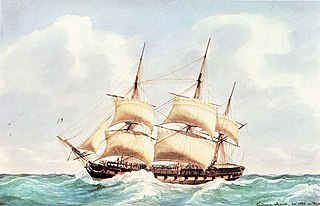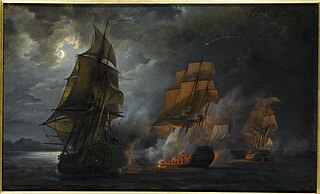
The Fantasque was a Lion-class 64-gun ship of the line of the French Navy. She is famous for being captained by the French commander Pierre-André de Suffren during the American Revolutionary War.

Surveillante was an Iphigénie-class 32-gun frigate of the French Navy. She took part in the Naval operations in the American Revolutionary War, where she became famous for her battle with HMS Quebec; in 1783, she brought the news that the war was over to America. She later took part in the French Revolutionary Wars, and was eventually scuttled during the Expédition d'Irlande after sustaining severe damage in a storm. The wreck was found in 1979 and is now a memorial.

Neptune was a 74-gun ship of the line of the French Navy.

The Conquérant was originally designed and built by François Coulomb the Younger at Toulon from 1745 to 1747, as a modified version of the same constructor's Terrible built at the same dockyard in 1736-40. In need of major repairs by early 1755, she was not employed throughout the Seven Years' War, after which she was formally taken out of service on 17 March 1764 and was rebuilt by Joseph-Louis Ollivier at Brest from January to December 1765 as a Citoyen-class 74-gun ship of the line of the French Navy.

HMS Chatham was a 50-gun fourth rate ship of the line of the Royal Navy, designed by Sir Joseph Allin and built by his son Edward Allin at Portsmouth Dockyard to the draught specified by the 1745 Establishment as amended in 1752, and launched on 25 April 1758.
HMS Antigua was a French frigate launched in 1779. She became a privateer that the British captured in 1804. She served the Royal Navy as a prison ship from 1804 to 1816, when she was broken up.

Hermione was a 32-gun Concorde-class frigate of the French Navy. Designed for speed, she was one of the first ships of the French Navy to receive a copper sheathing. At the beginning of the Anglo-French War of 1778, she patrolled in the Bay of Biscay, escorting convoys and chasing privateers. She became famous when she ferried General La Fayette to the United States in 1780 in support of the rebels in the American Revolutionary War. She took an incidental role in the Battle of Cape Henry on 16 March 1781, and a major one in the action of 21 July 1781.

Magicienne was a frigate of the French Navy, lead ship of her class. The British captured her in 1781 and she served with the Royal Navy until her crew burned her in 1810 to prevent her capture after she grounded at Isle de France. During her service with the Royal Navy she captured several privateers and participated in the Battle of San Domingo.

Engageante was a 26-gun frigate of the French Navy, only ship of her class, built to a design by Jean-François Etienne. The British captured her in 1794 and converted her to a hospital ship. She served as a hospital ship until she was broken up in 1811.

The action of 21 July 1781 was a naval skirmish off the harbour of Spanish River, Cape Breton, Nova Scotia, during the War of American Independence. Two light frigates of the French Navy, captained by La Pérouse and Latouche Tréville, engaged a convoy of 18 British ships and their Royal Navy escorts. The French captured one of the British escorts while the remainder of the British convoy escaped.

Hector was a 74-gun ship of the line of the French Navy, lead ship of her class. Hector was launched in 1755 and fought in the American Revolutionary War during which she captured two ships of the British Royal Navy on 14 August 1778. In 1782, the ship was captured by the Royal Navy at the Battle of the Saintes in 1782. Taken into service by the Royal Navy, the vessel was renamed HMS Hector. On 5 September 1782. HMS Hector fought two French frigates. Severely damaged during the battle, and by a hurricane that followed later in September, Hector sank on 4 October 1782.

Astrée was a 32-gun Nymphe-class frigate of the French Navy. She served in the War of American Independence under Captain Lapérouse, notably taking part in the action of 21 July 1781 and the Hudson Bay expedition. During the French Revolutionary Wars, she took part in the Atlantic campaign of May 1794. Astrée was wrecked in 1796

Éveillé was an Artésien-class 64-gun ship of the line of the French Navy, launched in 1772.
Charles Louis de Bernard de Marigny was a French Navy officer. He served in the War of American Independence.
Armand Le Gardeur de Tilly was a French Navy officer. He served in the War of American Independence.
Jean-Marie de Villeneuve Cillart was a French Navy officer. He served in the War of American Independence.
Actionnaire was a 64-gun ship of the line of the French Navy. Originally built for the French East India Company, she was purchased by the Navy and saw service during the War of American Independence.

Triton was a 64-gun ship of the line of the French Navy designed by François Coulomb the Younger. She took part in the Seven Years' War and in the War of American Independence.
Victurnien-Henri-Elzéar de Rochechouart de Mortemart was a French Navy officer. He served in the War of American Independence, and became a member of the Society of the Cincinnati.
Sibylle was a 32-gun copper-hulled, frigate of the French Navy, lead ship of her class.












